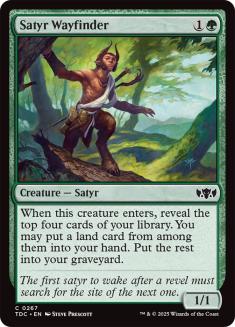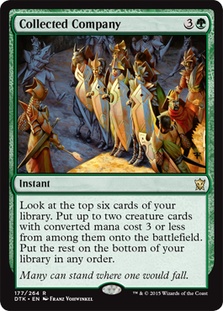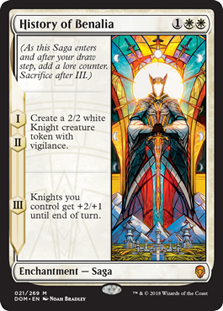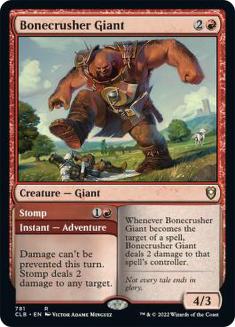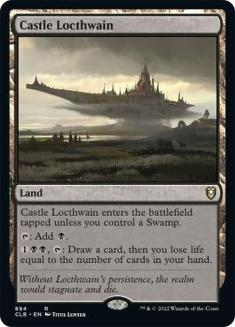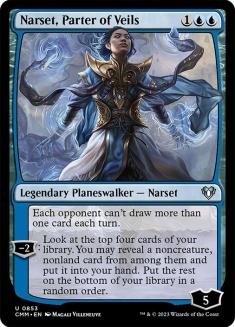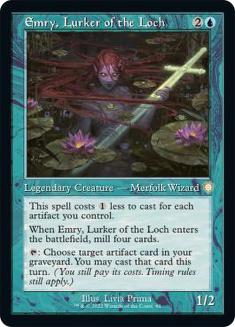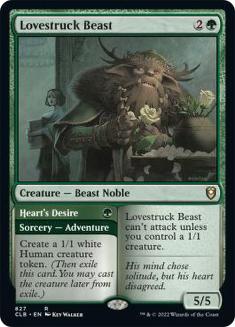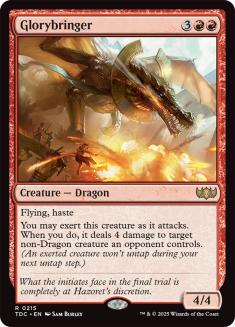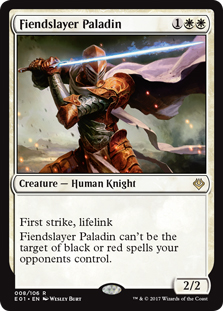The Players’ Championship this past weekend was quite the spectacle, culminating in the crowning of a very deserving champion, my good friend and teammate Oliver Tomajko. From wild swings on Friday to the stacked Top 4 on Sunday playing it out under the bright lights, the event was nearly perfect.
Perfect, that is, except for the small matter of the missing format. The one that Cedric and the crew decided to add to the Season Two Invitational to boost excitement and novelty. The one that keeps me invested in brewing, refining, and competing week after week. Where was the Pioneer?

Don’t get me wrong, Legacy is an incredible and rich format, though it’s hard to see where it goes from here. (The real answer? Probably primarily online, with occasional special events drawing the tabletop crowd out to play.) Modern has long been the favorite format for a ton of grinders, as it’s dynamic, varied, and powerful, with an insanely deep card pool. Unfortunately, it too has gotten a bit inbred with Veil of Summer pushing Thoughtseize / Fatal Push decks away and making green decks nearly unstoppable.
And Standard? There are a lot of problems with Standard, though the seed of an interesting format is still there, and it could very well become as good as we all want it to be once Theros Beyond Death is released.
But Pioneer is where the most interesting Magic happens today. It’s still quite a raw format, with tons of room to get an edge. There are no fewer than a dozen distinct archetypes that a sharp player can confidently use for a given tournament. Within those powerful decks, there are scores of individual card choices that could make or break an event. We still haven’t quite optimized our decks, and this upcoming Players’ Tour event stands to be one of the most breakable in years.
Which cards should we be looking at more closely? Which are not seeing the play they deserve? Keep these cards in mind as you continue to optimize your lists. No matter what, there will be room to get an edge in a format as new as Pioneer.
10. Satyr Wayfinder
This is both a stand-in for the brand-new Sultai No-Gaak (or Dredgeless Dredge) deck, and as a critical piece for any future Sultai or Temur Emerge deck that may come up as the format evolves.
Wayfinder is unassuming at first, but it does so much for only two mana. It digs deep for a third land drop, hitting nearly 90% of the time in most decks and improving consistency across the board. It also dumps a handful of cards into the graveyard, which is critical for hard graveyard decks with Narcomoeba, Prized Amalgam, and Creeping Chill as well as softer graveyard decks with delirium or delve synergies. Traverse the Ulvenwald can be as broken as Once Upon a Time with enablers like Satyr Wayfinder to consistently turn it on!
And, of course, Wayfinder offers a 1/1 body to sit on the battlefield, which eventually means it can be sacrificed for an Elder Deep-Fiend in an Emerge deck or block on a key turn of a race for the more all-in Dredge-style deck.
In decks with cards like Grisly Salvage or Gather the Pack, Satyr Wayfinder is the best enabler in the deck. I expect it to be one of the cards that slowly creeps up in utility as people remember that it exists and eventually becomes as integral to the format as Llanowar Elves is now.
Creatures (26)
- 4 Narcomoeba
- 4 Satyr Wayfinder
- 2 Gurmag Angler
- 2 Tasigur, the Golden Fang
- 4 Prized Amalgam
- 4 Haunted Dead
- 2 Scrapheap Scrounger
- 4 Stitcher's Supplier
Lands (19)
Spells (15)

9. Collected Company
People are still sleeping on this card! Ross Merriam has written about it, Kelvin Chew continues to win with it, and the memories of Bant Company in Standard in 2016 are still fresh for those of us who remember.
Yet it seems like everyone is obsessed with Green Devotion to the exclusion of Company!
The card is awfully nice with Deputy of Detention and Selfless Spirit in the mix, I have to say. And you can (and should) play with it now that Oko is banned, as well as another important green threat on this very list. You can flash in up to ten power with this one card, and most opponents simply won’t be able to beat that type of tempo swing.
There are a lot of good reasons to want to play Green-based Devotion with Nykthos and Nissa in Pioneer, for sure. The deck has a high percentage of busted draws. But Spell Queller and friends are impressive too, and you would do well not to forget it. With the right sideboard cards, the various Collected Company decks are poised to take over Pioneer. Bant Company, Temur Company, or even the old Rally the Ancestors or Cryptolith Rite Company decks might be worth checking out.
Creatures (31)
- 4 Llanowar Elves
- 4 Elvish Mystic
- 4 Tireless Tracker
- 4 Spell Queller
- 4 Selfless Spirit
- 4 Deputy of Detention
- 4 Lovestruck Beast
- 3 Brazen Borrower
Planeswalkers (3)
Lands (22)
Spells (4)

8. History of Benalia
Folks just forgot about History of Benalia, it seems. The card was decent in Standard, alternating between playable and incredible depending on where the metagame cycle landed in a given week. When the prevalent removal of a format is mostly one-for-one spot removal, the best token-generating cards will tend to pick up in value. It happened occasionally over the course of History’s long Standard tenure, and the card became superb. Yet again, that’s exactly what’s happening here in Pioneer. History of Benalia is even better than it was in Standard, as there is a high enough density of good Knights to make the bonus Chapter III ability a game-winning boost.
The deck that QBTurtle15 played to a 5-0 finish in the most recent Pioneer League deck dump is worth serious consideration, not only because of History of Benalia as the buff of the century, but also because of the sneaky-good power in Knight of the White Orchid. The only card that doesn’t synergize perfectly with the rest of the deck is Thalia’s Lieutenant, but even that card makes sense given how many Humans there are (and the fact that Worthy Knight generates Human tokens, not Knights!)
There’s no denying the fact that white is underpowered in Pioneer due to the lack of good removal, but with History of Benalia, the right weekend could come along to make this deck a real contender!
Creatures (32)
- 4 Knight of the White Orchid
- 4 Thalia's Lieutenant
- 4 Benalish Marshal
- 4 Dauntless Bodyguard
- 4 Inspiring Veteran
- 4 Venerable Knight
- 4 Worthy Knight
- 4 Fervent Champion
Lands (20)
Spells (8)

7. Bonecrusher Giant
Some red decks are playing Searing Blood. Some are playing Goblin Chainwhirler. Folks, Bonecrusher Giant is the best red two-drop and the best red three-drop. It sits handsomely in the exile zone while Bomat Courier delivers a fresh new hand. It can be cast out of exile despite an Experimental Frenzy on the battlefield. It triggers Runaway Steam-Kin twice, which is critical on those churn turns when you’re really going all-out on your mana engine. It offers an extremely high density of cheap removal for the red deck while simultaneously bringing a four-power threat to the table for only three mana (which is something red never actually had before!)
That’s right. There has never been a 4/3 for 2R without a drawback in Magic’s history. Now, with Bonecrusher Giant, we get a 4/3 for 2R with a bonus, that also comes with a two-mana Shock attached, and that Shock also comes attached with a bonus! (Chuckle as your opponents try to cast Fog in 2019 when you have eight maindeck ways to incidentally counter it.)
Bonecrusher Giant, Wild Slash, Lightning Strike, and Wizard’s Lightning offer a ton of reach for red aggro decks, and allow you to maintain pressure while cheaply removing opponents’ threats.
Goblin Chainwhirler is no slouch, as we all know. But it’s a little slow for catching up to the green decks’ best starts, especially on the draw. They could have a Nissa on the battlefield by the time Chainwhirler comes down. In time, Bonecrusher Giant will be known as an obvious piece of every red deck, from the cheapest aggro deck to the biggest midrange pile. Until then, you can get an edge by playing it while others haven’t maxed it out.
6. Castle Locthwain
This card is just a better Library of Alexandria in most situations. There, I said it. Magic has gotten to the point where it’s not feasible to keep a massive hand and slowly react to threats one by one while drawing extra cards; it demands that you dump your hand swiftly, beating down or assembling a powerful battlefield while killing everything your opponent casts. It’s been a game that revolves around double-spell turns for some years now, and that means that people are going to have empty hands more often than full ones. Castle Locthwain is simply a Swamp that allows you to tap four mana to draw a card in the late-game. That’s unbelievable.
Some people recognize that Castle Locthwain is good. Cool. Now recognize that in concert with black’s dominance in the one-mana spell department (via Fatal Push and Thoughtseize), this card is probably the best land in Pioneer. Mutavault and Nykthos are both absurdly powerful too, but Castle Locthwain is ever-so-slightly more impressive in my experience.
Losing Smuggler’s Copter was a massive kick in the teeth to Mono-Black Aggro, but the deck exists in three or four separate forms now, between the midrangey Vampires deck, Sam Black’s impressive Devotion deck, Zombies, and the bedraggled Mono-Black Aggro without Copter or Night Market Lookout.
What’s the unifying theme here? Thoughtseize, Fatal Push, and Castle Locthwain. The spells are impressive. They’re efficient, the best in their class. The lands are what make the deck crush control and other midrange decks, though.
5. Narset, Parter of Veils
Dig Through Time gets a lot of hype in Pioneer. Rightly so, as the card is quite strong. But as the format settles, it seems like Narset, Parter of Veils has a role to play in blue midrange decks as both a semi-suspended Dig Through Time (as the second Impulse comes around after a turn) that also harms other blue decks’ ability to execute their gameplan.
Right now, Pioneer is very aggro-oriented. Mono-Red Aggro, Simic Devotion, Mono-Black Aggro, Mono-White Aggro, Green-based Devotion, NoGaak, and even Mono-Blue Devotion all aim to close the game out quickly.
The format is more about playing to the battlefield than sculpting the perfect hand. But watch and see, it will only take a few printings (and possible bannings) to change the face of the format forever. Ban an Oko here (Step 1: Done!), reprint an Oust there, and suddenly Narset becomes the most oppressive part of Pioneer.
This is the most speculative underrated card on the list. It’s not quite “Play me now!” good; it’s more “Keep me in your back pocket, for there will come a day when I become insane” good. After all, if Dig Through Time is busted, surely Narset is close enough to be pretty darn impressive herself.
4. Emry, Lurker of the Loch
A mix between Satyr Wayfinder and some type of absurd Yu-Gi-Oh! card, Emry should be out here in Pioneer recurring stuff like Walking Ballista or Hope of Ghirapur. For some reason it isn’t, though, and that is perplexing.
Emry occupies an interesting spot for a threat, mostly because she’s actually hard to kill with Fatal Push (since revolt isn’t a given like it is in Modern). She costs three mana but often acts like a two-drop, or even a one-drop. She drills through the deck for Gate to the Afterlife and allows you to recast it if you untap with her. In many ways, Emry seems like the perfect broken centerpiece to a Simic Scales deck or a Simic God-Pharaoh’s Gift deck, both of which would be fine alternatives to the green-based decks that currently sit at the top of the format.
I’ve written about Simic God-Pharaoh’s Gift before, but here’s a list I’ve been sitting on, waiting to see if the opportunity is there to play it. I suspect that time will come sooner rather than later.
Creatures (33)
- 4 Llanowar Elves
- 4 Elvish Mystic
- 2 Cultivator of Blades
- 3 Verdurous Gearhulk
- 4 Servant of the Conduit
- 4 Minister of Inquiries
- 4 Walking Ballista
- 4 Emry, Lurker of the Loch
- 4 Merfolk Secretkeeper
Lands (21)
Spells (6)

It’s unclear if the Verdurous Gearhulk and Cultivator of Blades spots are better than alternatives like the Combat Celebrant package, but I’m always a fan of keeping the manabase as clean as possible. It will be interesting to see if the deck has legs, and if it’s better or worse than the other Llanowar Elves / Elvish Mystic options in Pioneer.
3. Lovestruck Beast
Kelvin Chew said it best, in the same Tweet where he sang the praises of his Bant Company list.
And he’s not wrong. The card is above the curve and absolutely backbreaking against aggro decks as a blocker. It comes with its own Turn 1 play when you don’t have an Elf, and barely any cheap removal spells kill it. Again, Fatal Push is not a reliable way to beat this card, and you have to go as far as Roast to kill it in red. (Incidentally, this is why I prefer Roast to Mizzium Mortars or Lava Coil in my red decks at the moment.)
It sees play in Bant Company as a way to get more Turn 1 plays while maintaining a high density of three-drops, in Green-based Aggro as a supplemental three-drop to Steel Leaf Champion, and even in Green-based Devotion as a sideboard card that pressures non-interactive opponents on decks like Simic Lotus Field or blocks against Mono-Red Aggro.
Sanity check: How many broken Throne of Eldraine cards are there, for Lovestruck Beast to barely scratch the Top 10 in the set but still be a secret star in Pioneer?
2. Glorybringer
Can’t shake this monster. Glorybringer is another savage threat that comes with a free removal spell built right in. Everyone basically understands that the card is insane, and the only reason it hasn’t taken over Pioneer is because folks are still trying to figure out the correct supporting cast. Should it be Big Red? Dragon Red? Eldrazi Red? Gruul with mana creatures? Even Temur Company?
It’s the perfect kind of card for a Jeskai Control deck to pick up in the sideboard and leverage as a threat once opponents sideboard out all their removal. It’s also a nice supplemental Dragon to go along with Nicol Bolas, the Ravager in some kind of Grixis Dragons control deck.
Basically, Glorybringer is a unique threat looking for the perfect home. It’s getting ignored because it doesn’t fit in any of the best decks in Pioneer at the moment. That’s the perfect example of an underrated all-star.
1. Fiendslayer Paladin
This card is just bananas. The fact that it was not included in the Boros Knights deck with History of Benalia is honestly shocking. Fiendslayer Paladin singlehandedly bricks two of the best aggro decks in the format, Mono-Red Aggro and Mono-Black Aggro. They can’t kill it. They probably can’t attack through it (especially if there’s any kind of pump involved, or if you have multiples of the card). It’s the kind of card that white decks can and should use to cheese out wins against a full 40% of the format. Obviously it’s bad against the Simic decks, but that’s why it’s been getting ignored as a sideboard staple! Plus, now that the Simic decks have been chopped down to size with the recent ban, Fiendslayer Paladin is poised to skyrocket.
Hook this creature up with any type of Equipment or some +1/+1 counters and watch as your opponent falls hopelessly behind. Honestly, it just seems silly to play something like Devout Decree and not play with Fiendslayer Paladin in a white aggro deck.
White decks are at their best when the prevalent interaction doesn’t line up with their creatures or when they have a high density of above-the-curve threats with at least one or two good removal spells to clear out blockers. In a format where the best removal spells are Fatal Push, Swift End, Wild Slash, and Stomp, Fiendslayer Paladin has the largest delta between reputation and playability.

